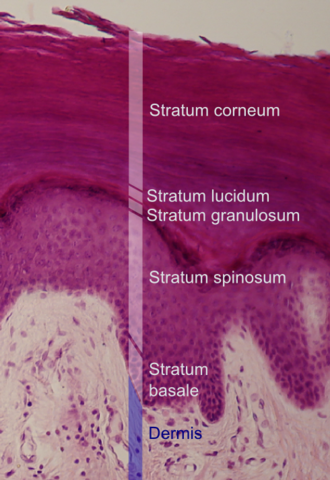The stratum spinosum (or spinous layer/prickle cell layer)[1] is a layer of the epidermis found between the stratum granulosum and stratum basale.[2] This layer is composed of polyhedral keratinocytes.[3][4] These are joined with desmosomes.[3] Their spiny (Latin, spinosum) appearance is due to shrinking of the microfilaments between desmosomes that occurs when stained with H&E. Keratinization begins in the stratum spinosum,[5] although the actual keratinocytes begin in the stratum basale.[4] They have large pale-staining nuclei as they are active in synthesizing fibrillar proteins, known as cytokeratin, which build up within the cells aggregating together forming tonofibrils. The tonofibrils go on to form the desmosomes, which allow for strong connections to form between adjacent keratinocytes. The stratum spinosum also contains Langerhans cells, which functions as a macrophage by engulfing bacteria, foreign particles, and damaged cells that occur in this layer.[6][7][8]

Clinical significance
editDiffuse hyperplasia of the stratum spinosum is termed acanthosis.[citation needed]
Additional images
edit-
Epidermis and dermis of human skin
-
Section of epidermis
See also
editReferences
edit- ^ Rook, Arthur; Burns, Tony (2004). Rook's textbook of dermatology. Blackwell Science. pp. 3.7–3.8. ISBN 978-0-632-06429-8. OCLC 55097298.
- ^ James, William D; Berger, Timothy G; Elston, Dirk M; Odom, Richard B (2006). Andrews' diseases of the skin: clinical dermatology. Saunders Elsevier. p. 2. ISBN 978-0-7216-2921-6. OCLC 62736861.
- ^ a b Barbieri, J.S.; Wanat, K.; Seykora, J. (2014). "Skin: Basic Structure and Function". Pathobiology of Human Disease. pp. 1134–1144. doi:10.1016/b978-0-12-386456-7.03501-2. ISBN 978-0-12-386457-4.
- ^ a b McBain, A.J.; o'Neill, C.A.; Oates, A. (2016). "Skin Microbiology". Reference Module in Biomedical Sciences. doi:10.1016/b978-0-12-801238-3.99217-1. ISBN 978-0-12-801238-3.
- ^ Marks, James G; Lookingbill, Donald P (2006). Lookingbill and Marks' principles of dermatology. Saunders Elsevier. p. 6. ISBN 978-1-4160-3185-7. OCLC 70829704.
- ^ Young, Barbara; Heath, John W; Stevens, Alan; Lowe, J S; Wheater, Paul R; Burkitt, H. George (2000). Wheater's functional histology: a text and colour atlas. Churchill Livingstone. ISBN 978-0-443-05612-3. OCLC 43051605.[page needed]
- ^ Di Meglio, Paola; Conrad, Curdin (2016). "Psoriasis, Cutaneous Lupus Erithematosus and Immunobiology of the Skin". Encyclopedia of Immunobiology. pp. 192–203. doi:10.1016/b978-0-12-374279-7.15008-8. ISBN 978-0-08-092152-5.
- ^
This article incorporates text available under the CC BY 4.0 license. Betts, J Gordon; Desaix, Peter; Johnson, Eddie; Johnson, Jody E; Korol, Oksana; Kruse, Dean; Poe, Brandon; Wise, James; Womble, Mark D; Young, Kelly A (June 28, 2023). Anatomy & Physiology. Houston: OpenStax CNX. 5.1 Layers of the skin. ISBN 978-1-947172-04-3.